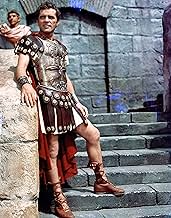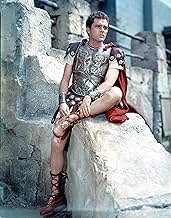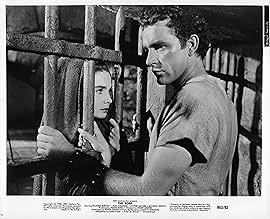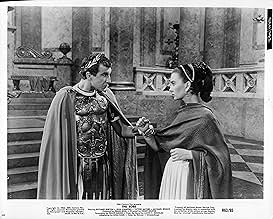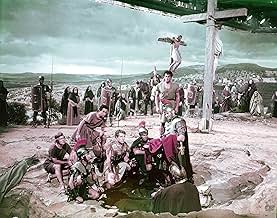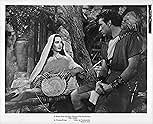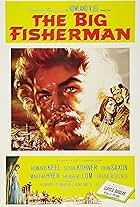In the Roman province of Judea during the 1st century, Roman tribune Marcellus Gallio is ordered to crucify Jesus of Nazareth but is tormented by his guilty conscience afterwards.In the Roman province of Judea during the 1st century, Roman tribune Marcellus Gallio is ordered to crucify Jesus of Nazareth but is tormented by his guilty conscience afterwards.In the Roman province of Judea during the 1st century, Roman tribune Marcellus Gallio is ordered to crucify Jesus of Nazareth but is tormented by his guilty conscience afterwards.
- Won 2 Oscars
- 7 wins & 6 nominations total
- Judas
- (uncredited)
- Slave Dealer
- (uncredited)
- Citizen
- (uncredited)
- Citizen
- (uncredited)
Storyline
Did you know
- TriviaRichard Burton was once threatened with a gun by Stewart Granger because of the affair he was having with Granger's wife Jean Simmons during filming.
- GoofsCaligula is depicted here and in the sequel Demetrius and the Gladiators (1954) as persecuting Christians. However, he reigned from 37 to 41, while Christianity was still a nascent religion with most of its followers in the eastern Mediterranean. The first mention of Christians from the perspective of the Roman government, according to the Roman historian Suetonius, wasn't until the reign of his successor Claudius (reigned 41-54). The first major incidents of persecution of Christians did not occur until the reign of Nero (54 to 68).
- Quotes
Diana: [Marcellus has just been sentenced to execution; Diana leaves the podium to stand at his side] Sire, Marcellus is my chosen husband. I wish to go with him.
Caligula: Stand back! You're not on trial! There's no evidence against you!
Diana: Then if it please you, sire, I'll provide evidence. I have no wish to live another hour in an empire ruled by *you*! You dare to call yourself a Caesar. Once the Caesars of Rome were noble, but in you, noble blood has turned to poison. You corrupt Rome with your spite and malice.
Caligula: Stop! Stop it!
Diana: That *you* should be Caesar, vicious, treacherous, drunk with power, an evil, insane monster posing as emperor.
Caligula: STOP IT!
Diana: As for me, I have found another king. I want to go with my husband into his kingdom.
Caligula: Then, by the gods, you shall! Go, both of you, into your kingdom!
- Alternate versionsIn 1997 the opening credits were altered to give top writing credit to Albert Maltz. Maltz had written the initial screenplay when the project was at R.K.O. Maltz's credit did not appear on prior prints because he was one of the "Hollywood Ten" who was blacklisted.
- ConnectionsFeatured in Demetrius and the Gladiators (1954)
In this case it is Jesus's robe that he wore to the crucifixion. It is recorded that while He was on the cross waiting to die, Roman soldiers idled their time away by casting dice for the only possession He took to his death, his robe. The lucky winner turned out to be Richard Burton, a tribune recently sent on assignment because of a running feud with the Emperor to be.
The run in with Caligula was over a slave purchased by Burton, a Greek named Demetrius played by Victor Mature. Both Burton and Mature are exiled to Judea and they arrive just in time to see Jesus enter Jerusalem. Mature becomes converted to Jesus's teachings and Burton is driven mad by the enormity of what he has participated in.
The Robe was written by Lloyd C. Douglas who was an ordained Lutheran minister and who turned to writing at the age of 50 with his first best seller Magnificent Obsession. His writings were of the Christian inspirational variety and he was a very popular American writer right up to his death in 1951.
Richard Burton got one of his Academy Award nominations for his role. Jean Simmons as Diana who was the main source of his rivalry with Caligula gives a good understated performance of the woman who stood by the man she loved and his fate and passed up a chance to be an Empress.
Jay Robinson as Caligula got most of the notice. Although John Hurt in the I Claudius series is probably now the definitive Caligula, Robinson's performance holds up very well indeed. A substance abuse problem curtailed a promising career and though he did come back it was not the same.
The Robe was 20th Century Fox's first film in its new wide screen process of Cinemascope and really should be seen in a letter box version at home. Richard Burton is always good and elevates whatever film he's in.
Though in this case the subject matter is elevated just about as high as it can get.
- bkoganbing
- May 17, 2006
- Permalink
- How long is The Robe?Powered by Alexa
Details
Box office
- Budget
- $5,000,000 (estimated)
- Gross US & Canada
- $36,000,000
- Gross worldwide
- $36,010,866
- Runtime2 hours 15 minutes
- Color
Contribute to this page



